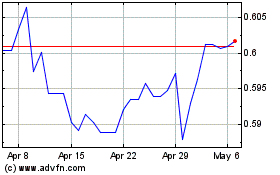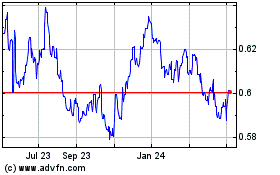U.S. Dollar Advances On Rising Treasury Yields
03 March 2021 - 8:57PM
RTTF2
The U.S. dollar was higher against its major counterparts in the
European session on Wednesday, as Treasury yields ticked up on
hopes that U.S. fiscal stimulus and vaccine rollouts will boost the
global economic recovery and spur inflation.
U.S. President Joe Biden said Tuesday that the U.S. expects to
take delivery of enough coronavirus vaccines for all adults by the
end of May, two months earlier than anticipated, after Merck &
Co agreed to produce rival Johnson & Johnson's newly approved
shot.
Biden also announced he would be using the powers of the federal
government to direct all states to prioritize vaccinating teachers,
and said the federal government would provide the doses directly
through its pharmacy program.
Investors cheered progress in the $1.9 trillion relief package,
which will be taken up by the Senate later in the day.
Democrats are racing to get it approved before March 14, when
some aid expire.
Data from payroll processor ADP showed that U.S. private sector
employment increased much less than expected in February.
ADP said private sector employment rose by 117,000 jobs in
February after climbing by an upwardly revised 195,000 jobs in
January.
Economists had expected employment to increase by 177,000 jobs
compared to the addition of 174,000 jobs originally reported for
the previous month.
The Labor Department is scheduled to release its more closely
watched monthly employment report on Friday, which includes both
public and private sector jobs.
The dollar gained in the Asian session as accelerated vaccine
rollouts and coronavirus aid package boosted hopes of the economic
recovery.
The greenback appreciated to 0.9189 against the franc and 1.2043
against the euro, after falling to 0.9140 and a 5-day low of
1.2113, respectively in early deals. The greenback is seen finding
resistance around 0.94 against the franc and 1.18 against the
euro.
The greenback reversed from an early 5-day low of 1.4007 against
the pound, with the pair trading at 1.3942. On the upside, 1.37 is
possibly seen as its next resistance level.
Survey results from IHS Markit and Chartered Institute of
Procurement & Supply showed that the UK service sector output
declined only moderately in February after a sharp downturn at the
start of 2021, as the third national lockdown has caused limited
damage to the economy.
The final services Purchasing Managers' Index rose to 49.5 in
February from an eight-month low of 39.5 in January. The flash
score was 49.7.
The greenback edged up to 0.7245 against the kiwi, 0.7771
against the aussie and 1.2658 against the loonie, up from its prior
low of 0.7305, 5-day lows of 0.7838 and 1.2593, respectively. If
the greenback rises further, 0.70, 0.75 and 1.20 are possibly seen
as its next resistance levels against the kiwi, the aussie and the
loonie, respectively
The greenback touched 107.08 against the yen, its highest level
since July, 2020. The currency is poised to find resistance around
the 109 level.
The latest survey from Jibun Bank showed that Japan services
sector continued to contract in February, albeit at a slower pace,
with a services PMI score of 46.3.
That's up from 46.1 in January, although it remains beneath the
boom-or-bust line of 50 that separates expansion from
contraction.
U.S. ISM non-manufacturing PMI for February will be published at
10:00 am ET.
NZD vs US Dollar (FX:NZDUSD)
Forex Chart
From Mar 2024 to Apr 2024

NZD vs US Dollar (FX:NZDUSD)
Forex Chart
From Apr 2023 to Apr 2024
